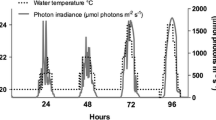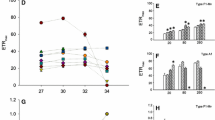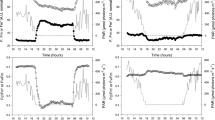Abstract
Elevated seawater temperatures have long been accepted as the principal stressor causing the loss of symbiotic algae in corals and other invertebrates with algal symbionts (i.e., “bleaching”). A secondary factor associated with coral bleaching is solar irradiance, both its visible (PAR: 400–700 nm) and ultraviolet (UVR: 290–400 nm) portions of the spectrum. Here we examined the synergistic role of solar radiation on thermally induced stress and subsequent bleaching in a common Caribbean coral, Montastraea faveolata. Active fluorescent measurements show that steady-state quantum yields of photosystem II (PSII) fluorescence in the zooxanthellae are markedly depressed when exposed to high solar radiation and elevated temperatures, and the concentration of D1 protein is significantly lower in high light when compared to low light treatments under the same thermal stress. Both photosynthetic pigments and mycosporine-like amino acids (MAAs) are also depressed after experimental exposure to high solar radiation and thermal stress. Host DNA damage is exacerbated under high light conditions and is correlated with the expression of the cell cycle gene p 53, a cellular gatekeeper that modulates the fate of damaged cells between DNA repair processes and apoptotic pathways. These markers of cellular stress in the host and zooxanthellae have in common their response to the enhanced production of reactive oxygen species during exposure to high irradiances of solar radiation and elevated temperatures. Taking these results and previously published data into consideration, we conclude that thermal stress during exposure to high irradiances of solar radiation, or irradiances higher than the current photoacclimatization state, causes damage to both photochemistry and carbon fixation at the same time in zooxanthellae, while DNA damage, apoptosis, or necrosis are occurring in the host tissues of symbiotic cnidarians.






Similar content being viewed by others
Abbreviations
- σPSII :
-
Functional absorption cross-section for PSII
- Fo, Fm :
-
Minimum and maximum yields of chlorophyll a fluorescence measured after dark acclimation (relative units)
- Fv :
-
Variable fluorescence after dark acclimation (=Fm−Fo), dimensionless
- Fv/Fm :
-
Maximum quantum yield of photochemistry in PSII measured after dark acclimation, dimensionless
- F′, Fm′:
-
Steady-state and maximum yields of chlorophyll a fluorescence measured under ambient light (relative units)
- ΔF/Fm′:
-
Quantum yield of photochemistry in PSII measured at steady state under ambient light
References
Anderson S, Zepp R, Machula J, Santavy D, Hansen L, Mueller D (2001) Indicators of UV exposure in corals and their relevance to global climate change and coral bleaching. Human Ecol Risk Asses 7:1271–1282
Asada K, Takahashi M (1987) Production and scavenging of active oxygen in photosynthesis. In: Kyle DJ, Osmond CB, Arntzen CJ (eds) Photoinhibition. Elsevier, Amsterdam, pp 228–287
Bhagooli R, Hidaka M (2004) Photoinhibition, bleaching susceptibility and mortality in two scleractinian corals, Platygyra ryukyuensis and Stylophora pistillata, in response to thermal and light stresses. Comp Biochem Physiol 137:547–555
Bradford MM (1976) A rapid and sensitive method for the quantitation of microgram quantities of protein using the principle of protein-dye binding. Anal Biochem 72:248–254
Brown BE, Ambarsari I, Warner ME, Fitt WK, Dunne RP, Gibb SW, Cummings DG (1999) Diurnal changes in photochemical efficiency and xanthophylls concentrations in shallow water reef corals: evidence for photoinhibition and photoprotection. Coral Reefs 18:99–105
Downs CA, Fauth JE, Halas JC, Dustan P, Bemiss J, Woodley CM (2002) Oxidative stress and seasonal coral bleaching. Free Radical Biol Med 33:533–543
Downs CA, Mueller E, Phillips S, Fauth JE, Woodley CM (2000) A molecular biomarker system for assessing the health of coral ( Montastraea faveolata) during heat stress. Mar Biotechnol 2:533–544
Dunlap WC, Chalker BE (1986) Identification and quantitation of near-UV absorbing compounds (S-320) in a hermatypic scleractinian. Coral Reefs 5:153–159
Dunlap WC, Yamamoto Y (1995) Small-molecule antioxidants in marine organisms: antioxidant activity of mycosporine-glycine. Comp Biochem Physiol 112B:106–114
Dunn SR, Bythell JC, Le Tessier MDA, Burnett WJ, Thomason JC (2002) Programmed cell death and cell necrosis activity during hyperthermic stress-induced bleaching of the symbiotic sea anemone Aiptasia sp. J Exp Mar Biol Ecol 272:29–53
Dunne RP, Brown BE (2001) The influence of solar radiation on bleaching of shallow water reef corals in the Andaman Sea, 1993–1998. Coral Reefs 20:201–210
Dustan P (1982) Depth-dependent photoadaptation by zooxanthellae of the reef coral Montastrea annularis. Mar Biol 68:253–264
Dykens JA, Shick JM (1982) Oxygen production by endosymbiotic algae controls superoxide dismutase activity in their animal host. Nature 297:579–580
Dykens JA, Shick JM, Benoit C, Buettner GR, Winston GW (1992) Oxygen radical production in the sea anemone Anthopleura elegantissima and its symbiotic algae. J Exp Biol 168:219–241
Evans G, Littlewood T (1998) A matter of life and cell death. Science 281:1317–1322
Falkowski PG, Kolber Z (1993) Estimate of phytoplankton photosynthesis by active fluorescence. ICES Mar Sci Symp 197:92–103
Fitt Wk, Brown BE, Warner ME, Dunne RP (2001) Coral bleaching: interpretation of thermal tolerance limits and thermal thresholds in tropical corals. Coral Reefs 20:51–65
Fitt WK, Spero HJ, Halas J, White MW, Porter JW (1993) Recovery of the coral Montastrea annularis in the Florida Keys after the 1987 Caribbean “bleaching event”. Coral Reefs 12:57–64
Fridovich I (1986) Biological effects of the superoxide radical. Arch Biochem Biophys 247:1–11
Fridovich I (1998) Oxygen toxicity: a radical explanation. J Exp Biol 201:1203–1209
Gates RD, Baghdasarian G, Muscatine L (1992) Temperature stress causes host cell detachment in symbiotic cnidarians: implications for coral bleaching. Biol Bull 182: 324–332
Genty B, Briantais JM, Baker NR (1989) The relationship between the quantum yield of photosynthetic electron transport and quenching of chlorophyll fluorescence. Biochem Biophys Acta 990:87–92
Gleason DF, Wellington GM (1993) Ultraviolet radiation and coral bleaching. Nature 365:836–838
Glynn PW (1991) Coral reef bleaching in the 1980s and possible connections with global warming. Trends Ecol Evol 6:175–179
Glynn PW, D’Croz L (1990) Experimental evidence for high temperature stress as the cause of El Niño-coincident coral mortality. Coral Reefs 8:181–191
Glynn PW, Imai R, Sakai K, Nakano Y, Yamazato K (1992) Experimental responses of Okinawan (Ryukyu Islands, Japan) reef corals to high sea temperature and UV radiation. In: Richmond R (ed) Proceedings of the Seventh Coral Reef Symposium, Guam. University of Guam, pp 27–37
Gorbunov M, Falkowski PG, Kolber Z (2000) Measurement of photosynthetic parameters in benthic organisms in situ using a SCUBA-based fast repetition rate fluorometer. Limnol Oceanogr 45:242–245
Gorbunov M, Kolber ZS, Lesser MP, Falkowski PG (2001) Photosynthesis and photoprotection in symbiotic corals. Limnol Oceanogr 46:75–85
Greenberg BM, Gaba V, Canaani O, Malkin S, Mattoo AK, and Edelman M (1989) Separate photosensitizers mediate degradation of the 32 kDa photosystem II reaction center protein in the visible and UV spectral regions. Proc Natl Acad Sci 86:6617–6620
Hale AJ, Smith CA, Sutherland LC, Stoneman VE, Longthorne VL, Culhane AC, Williams GT (1996) Apoptosis: molecular regulation of cell death. Eur J Biochem 236:1–26
Halliwell B, Gutteridge JMC (1999) Free radicals in biology and medicine. Oxford Science Publications, London, 936 pp
Hengartner MO (2000) The biochemistry of apoptosis. Nature 407:770–776
Hoegh-Guldberg O (1999) Climate change, coral bleaching and the future of the world’s coral reefs. Mar Freshwater Res 50:839–866
Hoegh-Guldberg O, Jones RJ (1999) Photoinhibition and photoprotection in symbiotic dinoflagellates from reef-building corals. Mar Ecol Prog Ser 183:73–86
Hoegh-Guldberg O, Smith GJ (1989) The effect of sudden changes in temperature, light and salinity on the population density and export of zooxanthellae from the reef corals Stylophora pistillata Esper and Seriatopora hystrix Dana. J Exp Mar Biol Ecol 129:279–303
Iglesias-Prieto R, Matta JL, Robins WA, Trench RK (1992) Photosynthetic response to elevated temperature in the symbiotic dinoflagellate Symbiodinium microadriaticum in culture. Proc Natl Acad Sci 89:10302–10305
Imlay JA, Linn S (1988) DNA damage and oxygen radical toxicity. Science 240:1302–1309
Inglesias-Prieto R, Trench RK (1994) Acclimation and adaptation to irradiance in symbiotic dinoflagellates. I. Responses of the photosynthetic unit to changes in photon flux density. Mar Ecol Prog Ser 113:163–175
Inglesias-Prieto R, Trench, RK (1997) Acclimation and adaptation to irradiance in symbiotic dinoflagellates. II. Response of chlorophyll-protein complexes to different photon-flux densities. Mar Ecol Prog Ser 130:23–33
Jeffrey SW, Humphrey GF (1975) New spectrophotometric equations for determining chlorophylls a, b, c , and c 2 in higher plants, algae and natural phytoplankton. Biochem Physiol Pflanzen 167:191–194
Jokiel PL, Coles SL (1990) Responses of Hawaiian and other Indo-Pacific reef corals to elevated temperatures. Coral Reefs 8:155–162
Jokiel PL, Lesser MP, Ondrusek ME (1997) UV-absorbing compounds in the coral Pocillopora damicornis: interactive effects of UV radiation, photosynthetically active radiation, and water flow. Limnol Oceanogr 42:1468–1473
Jones RJ, Hoegh-Guldberg O, Larkum AWD, Schreiber U (1998) Temperature-induced bleaching of corals begins with impairment of the CO2 fixation mechanism in zooxanthellae. Plant Cell Environ 21:1219–1230
Kelly ML, Winge P, Heaney JD, Stephens RE, Farell JH, Van Beneden RJ, Reinisch CL, Lesser MP, Walker CW (2001) Expression of homologues for p53 and p73 in the softshell clam ( Mya arenaria), a naturally-occurring model for human cancer. Oncogene 20:748–758
Kim CS, Lim WA, Cho YC (2001) Mycosprine-like amino acids as the UV sunscreen with oxygen radical scavenging activity. Bull Natl Fish Res Dev Inst Korea 60:65–71
Kirk JTO (1994) Optics of UV-B radiation in natural waters. Arch Hydrobiol Ergebnisse der Limnologie 43:1–16
Kolber Z, Prasil O, Falkowski PG (1998) Measurements of variable chlorophyll fluorescence using fast repetition rate techniques: defining methodology and experimental protocols. Biochem Biophys Acta 1367:88–106
LaJeunesse TC (2002) Diversity and community structure of symbiotic dinoflagellates from Caribbean coral reefs. Mar Biol 141:387–400
Lasker HR, Peters EC, Coffroth MA (1984) Bleaching of reef coelenterates in the San Blas Islands, Panama. Coral Reefs 3:183–190
Lesser MP (1996) Exposure of symbiotic dinoflagellates to elevated temperatures and ultraviolet radiation causes oxidative stress and inhibits photosynthesis. Limnol Oceanogr 41:271–283
Lesser MP (1997) Oxidative stress causes coral bleaching during exposure to elevated temperatures. Coral Reefs 16:187–192
Lesser MP (2000) Depth-dependent effects of ultraviolet radiation on photosynthesis in the Caribbean coral, Montastraea faveolata. Mar Ecol Prog Ser 192:137–151
Lesser MP, Gorbunov MY (2001) Diurnal and bathymetric changes in chlorophyll fluorescence yields of reef corals measured in situ with a fast repetition rate fluorometer. Mar Ecol Prog Ser 212:69–77
Lesser MP, Lewis S (1996) Action Spectra for the Inhibition of Photosynthesis by Ultraviolet Radiation in the Hermatypic Coral, Pocillopora damicornis. Mar Ecol Prog Ser134:171–177
Lesser MP, Shick JM (1989) Effects of irradiance and ultraviolet radiation on photoadaptation in the zooxanthellae of Aiptasia pallida: primary production, photoinhibition, and enzymic defenses against oxygen toxicity. Mar Biol 102:243–255
Lesser MP, Stochaj WR, Tapley DW, Shick JM (1990) Bleaching in coral reef Anthozoans: effects of irradiance, ultraviolet radiation and temperature, on the activities of protective enzymes against active oxygen. Coral Reefs 8:225–232
Lesser MP, Turtle SL, Farrell JH, Walker CW (2001) Exposure to ultraviolet radiation (290–400 nm) causes oxidative stress, DNA damage, and expression of p 53/73 in laboratory experiments on embryos of the spotted salamander, Ambystoma maculatum. Physiol Biochem Zool 74:733–741
Lupínková L, Komenda J (2004) Oxidative modifications of the photosystem II D1 protein by reactive oxygen species: from isolated protein to cyanobacterial cells. Photochem Photobiol 79:152–162
Macpherson AN, Telfer A, Barber J, Truscott TG (1993) Direct detection of singlet oxygen from isolated photosystem II reaction centers. Biochem Biophys Acta 1143:301–309
Marsh JA (1970) Primary productivity of reef-building calcareous algae. Ecology 51:255–263
Mori T, Nakane M, Hattori T, Matsunaga T, Ihara M, Nikaido O (1991) Simultaneous establishment of monoclonal antibodies specific for either cyclobutane pyrimidine dimers or (6–4) photoproduct from the same mouse immunized with ultraviolet radiated DNA. Photochem Photobiol 54:225–232
Mumby PJ, Chisholm JRM, Edwards AJ, Andrefouet S, Jaubert J (2001) Cloudy weather may have saved Society Island reef corals during 1998 ENSO event. Mar Ecol Prog Ser 222:209–216
Muscatine L, Porter JW, Kaplan IR (1989) Resource partitioning by reef corals as determined from stable isotope composition. I. 13C of zooxanthellae and animal tissue vs. depth. Mar Biol 100:185–193
Nishiyama Y, Yamamoto H, Allakhverdiev SI, Inaba M, Yokota A, Murata N (2001) Oxidative stress inhibits the repair of photodamage to the photosynthetic machinery. EMBO 20:5587–5594
Polyak K, Xla Y, Zweler JL, Kinzler KW, Vogelstein B (1997) A model for p 53 induced apoptosis. Nature 389:300–305
Renzing J, Hansen S, Lane DP (1996) Oxidative stress is involved in the UV activation of p 53. J Cell Sci 109:1105–1112
Richter M, Rühle W, Wild A (1990) Studies on the mechanism of photosystem II photoinhibition II. The involvement of toxic oxygen species. Photosyn Res 24:237–243
Rowan R, Knowlton N, Baker A, Jara J (1997) Landscape ecology of algal symbionts creates variation in episodes of coral bleaching. Nature 388:265–269
Rowan R, Whitney SM, Fowler A, Yellowlees D (1996) Rubisco in marine symbiotic dinoflagellates: Form II enzymes in eukaryotic oxygenic phototrophs encoded by a nuclear multigene family. Plant Cell 8:539–553
Shick JM, Dunlap WC, Chalker BE, Banaszak AT, Rosenzweig TK (1992) Survey of ultraviolet radiation-absorbing mycosporine-like amino acids in organs of coral reef holothuroids. Mar Ecol Prog Ser 90:139–148
Shick JM, Lesser MP, Jokiel PK (1996) Effects of ultraviolet radiation on corals and other coral reef organisms. Global Change Biol 2:527–545
Smith NP (2001) Weather and hydrographic conditions associated with coral bleaching: Lee Stocking Island, Bahamas. Coral Reefs 20:415–422
Strömgren T (1987) The effect of light on the growth rate of intertidal Acropora pulchra (Brook) from Phuket, Thailand, lat. 8° N. Coral Reefs 6:43–47
Sukenick A, Bennett J, Falkowski PG (1987) Light-saturates photosynthesis-limitation by electron transport or carbon fixation? Biochim Biophys Acta 891:205–215
Takahashi S, Nakamura T, Sakamizu M, van Woesik R, Yamasaki H (2004) Repair machinery of symbiotic photosynthesis as the primary target of heat stress for reef building corals. Plant Cell Physiol 45:251–255
Warner ME, Fitt WK, Schmidt GW (1996) The effect of elevated temperature on the photosynthetic efficiency of zooxanthellae in hospite from four different species of reef coral: a novel approach. Plant Cell Environ 19:291–299
Warner ME, Fitt WK, Schmidt GW (1999) Damage to photosystem II in symbiotic dinoflagellates: a determinant of coral bleaching. Proc Natl Acad Sci USA 96:8007–8012
Acknowledgments
This work was funded in part by a grant from the NOAA National Undersea Research Program through the Caribbean Marine Research Center at Lee Stocking Island, Bahamas. The views expressed herein are those of the author and do not necessarily reflect the views of NOAA or any of its sub-agencies. Support was also provided by the Office of Naval Research-Environmental Optics Program under Grant # 97PR00617–00 to MPL. I would like to thank the staff of Caribbean Marine Research Center at Lee Stocking Island for providing the field temperature data and excellent support during this work. I would like to thank Dr. Kozi Asada for the Cu/Zn SOD antibody and Dr. Toshio Mori for the CPD antibody. I would also like to thank Dr. Max Gorbunov for making the fast repetition rate fluorometer available for this work, and Drs. Chris Neefus and Geoff Trussell for assistance on the statistical analysis of the fluorescence data. The experiments conducted for this study comply with the current laws of the Bahamas and the United States of America.
Author information
Authors and Affiliations
Corresponding author
Additional information
Communicated by R.C. Carpenter
Rights and permissions
About this article
Cite this article
Lesser, M.P., Farrell, J.H. Exposure to solar radiation increases damage to both host tissues and algal symbionts of corals during thermal stress. Coral Reefs 23, 367–377 (2004). https://doi.org/10.1007/s00338-004-0392-z
Received:
Accepted:
Published:
Issue Date:
DOI: https://doi.org/10.1007/s00338-004-0392-z




